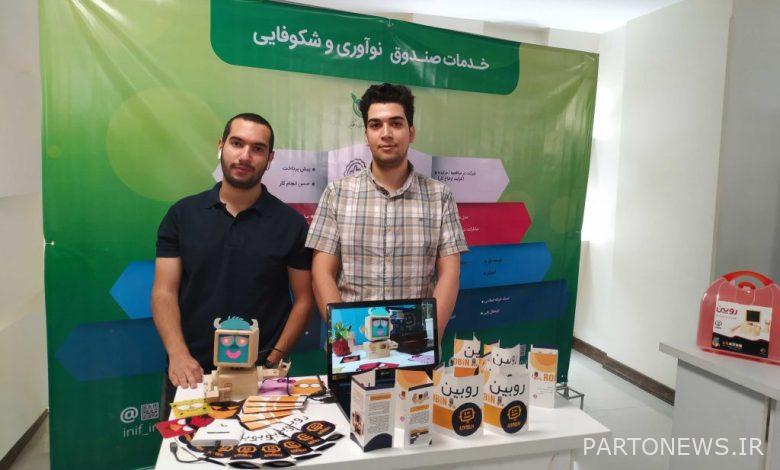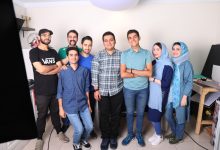Rubin, social robot teaching creativity and programming to children

The idea of using interactive robots to teach children has been considered for several years. The interesting thing about these robots is that even the opportunity to program the robot itself is used to teach the child, and children can customize their robot and design and implement interactive scenarios for the robot using simple and graphical programming languages. A hard-working Iranian team, a robot named Rubin has developed it according to the needs of the Iranian audience and hopes to be able to use the platform he created in areas other than teaching programming and creativity to children. Ammar Jalali Menesh is the manager of Rubin team. We have talked together.
Let’s start with Ammar Jalali Manesh
Ammar Jalali Manesh, PhD graduate in the field of industries from Amirkabir University of Technology and researcher at Munich Polytechnic University, and also the co-founder of Artificial Intelligence Accelerator partner I am
Tell us about Rubin
Rubin is an interactive robot for children made for educational purposes. Cognitive training, programming training, algorithmic thinking training and creativity are among the applications of Rubin.
Currently, there are two new approaches to education in the world, both of which have been considered for making this product. The first approach is Stem’s methodology (Science-Technology-Engineering-Mathematics), which says that you can no longer teach children science separately as in the past, but science and skills should be taught in a convergent manner. Robotics is one of the best educational tools because when children build robots, program them, and finally play with them, they learn the principles of mechanics, electronics, programming, mathematics, algorithms, and other sciences, and their creativity is strengthened. Another approach is gamification, which tries to move education from the traditional and classic format to game-based education.
Where did the idea for Rubin come from?
Based on this Ideas There are several foreign products in different forms; Because the idea of ”robotics for children” has become popular since about 5 years ago. There is an English product called OhBot, which is similar to our product, but it is different from it in terms of freedom of action, movements and, of course, language.
How successful have foreign examples been?
The feedback on foreign platforms has been very good and manufacturers have been able to sell a large number of products on platforms such as Amazon. The eyes of big companies are also focused on this product, as Microsoft has advertised this product on its website.
What advantages does Rubin have over foreign samples?
Apart from being Farsi-speaking, which is an important feature for the user, our robot is customizable and you can easily change its personality using the sliding pages inside the robot’s face. Another advantage is the cost of this robot. Many social bot platforms used in events and competitions in Iran are very expensive. For example, Nao is one of the famous robots in this competition, which currently costs more than 300 million tomans, but the finished price of our robot is around 500 thousand tomans, and it is much easier for families to buy it.
Have we already had experience in the country regarding the use of educational robots?
Programming for children has been in the spotlight for some time and several collections are teaching programming to children using the Scratch programming language. Some academies are already doing this with external platforms; So we were not the first ones to pursue this idea, people have also used it before us, but often it was not the case that they developed a product themselves, but they used foreign products. We also have exceptions, for example, the “Pishrobot” group, which developed a robot named “Hamster”, which was the result of making a series of changes on an external example.
Do you have feedback from the market? How will you enter the market?
We have already given 20 robots to customers in different groups, both in terms of income and expertise, and we are testing the product. A questionnaire has been prepared, which we provide to the user, and after using the robot for a week, he completes the questionnaire. We hope to complete the feedback in the next month to implement the corrections. Parallel to this, we are also active in the co-hosting platform Nick Starter.
We also plan to launch the robot in Digikala after the finalization of the product in the coming months. In addition, we have talked with organizations such as the library institution, and they have welcomed the idea of placing the robot in the library so that children can interact with it, and workshops and competitions can be organized around it. Another model we are considering is to interact with the country’s robotics programming trainers to introduce it more in the market with training based on the Rubin platform. We will probably develop another model of the robot in the future, in which the programming is not necessarily done by the user, but it has predetermined scenarios such as games, storytelling, Chistan, and so on.
How to teach programming through Rubin?
Rubin is based on Scratch (a simplified graphical programming language developed by the Media Lab at MIT) and we imported the robot controls into this programming language and added different scenarios to it. The bases and elements of the programming language such as: condition, variable definition, start and end of each program and repetition loops exist in the robot programming language; With this feature, the output of the program is seen in the robot functions instead of being seen in the programming environment. For example, you write a program to ask the robot a question; A question like: “What can you do?” And the robot answers: “I can shake my head or read a book or..” and when it is asked to turn its head, the robot asks: “how many degrees and how many times should I turn it” and It does exactly what it is asked to do.
This feature creates many advantages in the robot, because the child can experience the scenario he experiences with the teacher or his playmate with the robot and play with it. The child himself can do the programming related to these scenarios. It is possible to write an unlimited number of complex interactive scenarios for Robin, which distinguishes it from a typical robot that has limited functions.

At what stage is Rubin’s development?
The development of Rubin has gone through a one-year process and for the first time we reverse-engineered an English robot and after adding the Persian language and applying a series of changes, we produced it with the help of 3D printing. When the product to investor We introduced it, it was not accepted and we decided to redesign it and create a more attractive face for the robot. If we wanted to produce that product in large quantities, it would cost us a lot; For example, if we wanted to use plastic injection molds to produce a robot, several hundred million tomans of capital would be needed to start the work, which was not financially attractive with these production conditions. For this reason, we went towards the wooden design of the robot, which had two advantages: one, it allowed us to produce limited and customized products, and the other is that the wood, due to its naturalness, conveyed a good feeling to the use of the robot, and of course, as mentioned, There is a lot of flexibility in production with the help of wood.
What can be done around Rubin?
After presenting the product, we decide to provide new services; Create virtual forums so that children can interact in it. We will create robotics and stem training based on this platform and we can organize events and competitions based on this robot.
What steps will you take after Rubin?
This product has a large family, and its programming platform can take on different characters in the future, which can be used in addition to teaching programming, such as teaching language to children, or in the field of speech therapy and interaction with children. Outside of children’s space, we presented this platform to one of the banks and it was welcomed to be used instead of chatbot. In the field of children, the development of products based on Artificial intelligence we have in the program. Providing various educational aid games with artificial intelligence and combining these with virtual reality and augmented reality are attractive to us. We have also created a brand named Hopek (artificial intelligence for raising children) with the support of Chubin, Hemtek and Tetra collections, through which we plan to develop products in the field of artificial intelligence for children.

Did you attract capital to develop Rubin?
Yes, we attracted seed capital; We also got some support from the scientific vice president. Of course, at the beginning of the work, we spent part of the costs from our own pockets, and after that, the Hemtek accelerator helped the team.
Will the interaction you had with the academic vice-chancellor continue?
The Scientific Vice President of the Presidency has been one of our primary supporters, and the Digital Economy Headquarters, headed by Dr. Mehdi Mohammadi, provided us with material and spiritual assistance. In the following, we see opportunities to cooperate with the vice-president to hold the event, because we do not have content events for children and teenagers in the country. Robotics events held for children and teenagers are more focused on hardware topics and engage children less with other content and creativity; But in our robot, due to the existence of a ready hardware platform, children are more involved in content and creativity. On the other hand, in the discussion of artificial intelligence for children, no events are held at the country level, and for this reason, this robot can be the initiator of these types of events. The scientific vice-chancellor has also promised to cooperate in financing the expenses of holding such events.
You have interacted with another group for marketing or attracting capital?
We are interested in interacting with large companies in the field of education and toys for children; Because some of these companies are changing their traditional strategy and can be strategic partners for us. In recent years, these companies have been looking for innovation and, of course, they have a large market to which they can introduce new products. Considering the need of these companies for innovation and the ability that we have created, we can have a win-win cooperation with them.
How do you rate this article?

